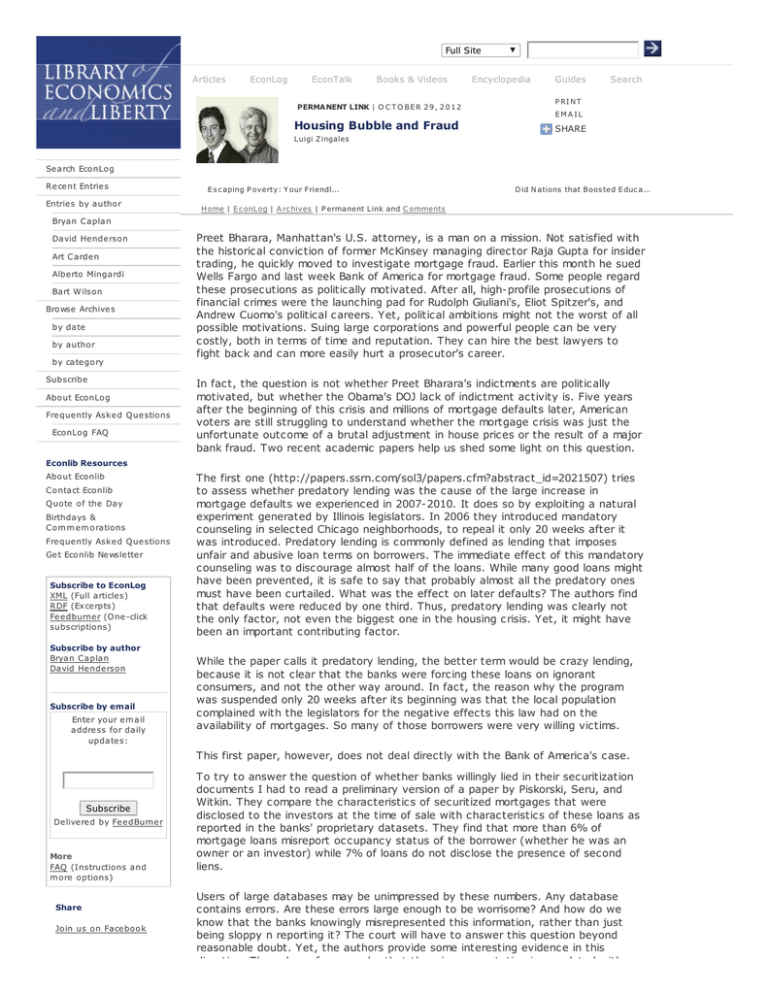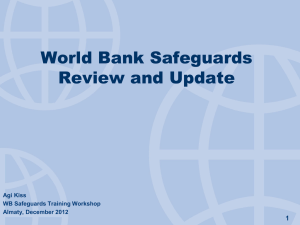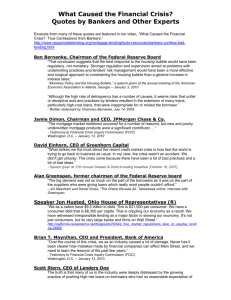Preet Bharara, Manhattan's U.S. attorney, is a man on a... the historical conviction of former McKinsey managing director Raja Gupta...
advertisement

Full Site Articles EconLog EconTalk Books & Videos PERMA NENT LINK | O C T O BE R 2 9 , 2 0 1 2 Housing Bubble and Fraud Encyclopedia Guides Search P RI N T EMA IL SHARE L uigi Zingales Se arch EconLog R e ce nt Entrie s Entrie s by author E s c aping P overty: Y our Friendl... D id N ations that Boos ted E duc a... H ome | E c onL og | A rc hives | P ermanent L ink and C omments Bryan C aplan David He nde rson Art C arde n Albe rto Mingardi Bart W ilson Browse Archive s by date by author by cate gory Subscribe About EconLog Fre que ntly Ask e d Q ue stions EconLog FAQ Preet Bharara, Manhattan's U.S. attorney, is a man on a mission. Not satisfied with the historical conviction of former McKinsey managing director Raja Gupta for insider trading, he quickly moved to investigate mortgage fraud. Earlier this month he sued Wells Fargo and last week Bank of America for mortgage fraud. Some people regard these prosecutions as politically motivated. After all, high-profile prosecutions of financial crimes were the launching pad for Rudolph Giuliani's, Eliot Spitzer's, and Andrew Cuomo's political careers. Yet, political ambitions might not the worst of all possible motivations. Suing large corporations and powerful people can be very costly, both in terms of time and reputation. They can hire the best lawyers to fight back and can more easily hurt a prosecutor's career. In fact, the question is not whether Preet Bharara's indictments are politically motivated, but whether the Obama's DOJ lack of indictment activity is. Five years after the beginning of this crisis and millions of mortgage defaults later, American voters are still struggling to understand whether the mortgage crisis was just the unfortunate outcome of a brutal adjustment in house prices or the result of a major bank fraud. Two recent academic papers help us shed some light on this question. Econlib Resources About Econlib C ontact Econlib Q uote of the Day Birthdays & C om m e m orations Fre que ntly Ask e d Q ue stions Ge t Econlib Ne wsle tte r Subscribe to EconLog XML (Full article s) R DF (Ex ce rpts) Fe e dburne r (O ne -click subscriptions) Subscribe by author Bryan C aplan David He nde rson Subscribe by email Ente r your e m ail addre ss for daily update s: The first one (http://papers.ssrn.com/sol3/papers.cfm?abstract_id=2021507) tries to assess whether predatory lending was the cause of the large increase in mortgage defaults we experienced in 2007-2010. It does so by exploiting a natural experiment generated by Illinois legislators. In 2006 they introduced mandatory counseling in selected Chicago neighborhoods, to repeal it only 20 weeks after it was introduced. Predatory lending is commonly defined as lending that imposes unfair and abusive loan terms on borrowers. The immediate effect of this mandatory counseling was to discourage almost half of the loans. While many good loans might have been prevented, it is safe to say that probably almost all the predatory ones must have been curtailed. What was the effect on later defaults? The authors find that defaults were reduced by one third. Thus, predatory lending was clearly not the only factor, not even the biggest one in the housing crisis. Yet, it might have been an important contributing factor. While the paper calls it predatory lending, the better term would be crazy lending, because it is not clear that the banks were forcing these loans on ignorant consumers, and not the other way around. In fact, the reason why the program was suspended only 20 weeks after its beginning was that the local population complained with the legislators for the negative effects this law had on the availability of mortgages. So many of those borrowers were very willing victims. This first paper, however, does not deal directly with the Bank of America's case. Subscribe De live re d by Fe e dBurne r More FAQ (Instructions and m ore options) Share Join us on Face book To try to answer the question of whether banks willingly lied in their securitization documents I had to read a preliminary version of a paper by Piskorski, Seru, and Witkin. They compare the characteristics of securitized mortgages that were disclosed to the investors at the time of sale with characteristics of these loans as reported in the banks' proprietary datasets. They find that more than 6% of mortgage loans misreport occupancy status of the borrower (whether he was an owner or an investor) while 7% of loans do not disclose the presence of second liens. Users of large databases may be unimpressed by these numbers. Any database contains errors. Are these errors large enough to be worrisome? And how do we know that the banks knowingly misrepresented this information, rather than just being sloppy n reporting it? The court will have to answer this question beyond reasonable doubt. Yet, the authors provide some interesting evidence in this direction. They show, for example, that the misrepresentation is correlated with SHAR E Return to top direction. They show, for example, that the misrepresentation is correlated with higher defaults down the line. Thus, it does not seem to be a random mistake, but a purposeful one. Yet, even in this case the effect seems to be reasonably small. Yes, probably there was fraud and the banks need to be sued, but the housing bubble and the subsequent crash was not driven by fraud or abusive practices. In fact, the fraud and the abusive mortgage terms seem the outcome of the euphoria surrounding the housing bubble, rather than its cause. To explain this euphoria economists have to work harder than lawyers. Comments and Sharing C A T E G O RI E S: Behavioral Economics and Rationality , Business Economics , Finance Email this C O M M E N T S (1 1 to date) L ates t C omment Steve Sailer writes: "To explain this euphoria economists have to work harder than lawyers." You can start by reading the press releases and speeches of Angelo Mozilo, CEO of Countrywide Financial (the firm acquired by Bank of America): http://isteve.blogspot.com/2012/10/i-am-shocked-shocked-to-learn-that.html Mozilo emphasized over and over that, just as President Bush had said, laxer standards were necessary to fight racist redlining. And if Angelo had to make hundreds of millions of dollars to fight racial inequality, well, that was a price he was willing to pay. Posted October 29, 2012 2:21 AM Mike W writes: ...crazy lending, because it is not clear that the banks were forcing these loans on ignorant consumers, and not the other way around. So many of those borrowers were very willing victims. The same can probably be said of the banks' sales of securitized instruments to investors...they were willing victims. Those investors were hedge funds, pension funds, banks, municipalities and insurance companies...all "sophisticated investors" who should have been expected to evaluate the risks in the securities they were buying. Just as consumers took the seemingly free money they were being offered, the investment managers for these institutions were not anxious to look at the teeth of a complimentary equine…especially since it was not their money they were investing. Posted October 29, 2012 10:48 AM Patrick R. Sullivan writes: Mozillo only got into the business of fighting 'redlining' after Henry Cisneros had a talk with him (as head of the Mortgage Bankers Assn.). "Nice little lending operation you've got there, be a shame if anything happened to it'. If the MBA members didn't 'voluntarily' sign on to HUD's Best Practices Initiative, then the CRA would be extended to them--the Democrats at the time, 1993, had the Presidency and both houses of congress. the Presidency and both houses of congress. That was the second step, after the GSE Act of 1992, in transforming the home lending industry. Banks weren't making these kinds of loans until then. They had to be forced to do so by the government and its community organizer friends. There were articles in banking journals back in the 1990s complaining about the new underwriting standards. Had they not been imposed, we'd never heard of a financial crisis. This time is truly different. Posted October 29, 2012 12:44 PM Patrick R. Sullivan writes: I'm amazed that the Boston Fed still has the pamphlet that mapped out the road to disaster, up on its website; Closing the Gap. Posted October 29, 2012 12:47 PM Steve Sailer writes: "Closing the Gap" The chairman of the Boston Fed at the time that pretty dim-witted but celebrated expose of racist redlining was published in 1991 was Richard Syron. Being associated with the Good Fight against Racism in Lending turbocharged his career, helping him become CEO of Freddie Mac, where he took home $38 million in compensation, before cratering that GSE. Posted October 29, 2012 10:26 PM EMichael writes: The idea that Mozilo fought redlining is beyond absurd. Less than 2% of Countrywide's loans were sold to CRA institutions. Geez, lending under the CRA was at its height in the early 90's, and declined steadily right through the bubble. Anyone notice the bubble did not happen in Detroit? Harlem? West Philly? Compton, CA? And why did it happen in Sesena, Spain? Why did the same thing happen in commercial real estate? Auto finance? Credit cards? "The Big Lie" is just that. Banks artificially created AAA buyers so they could access the investors restricted to AAA paper, and leverage that paper to the max. End of story Posted October 30, 2012 11:24 AM Rick Russell writes: > While many good loans might have been prevented, it is safe to say that probably almost all the predatory ones must have been curtailed. What was the effect on later defaults? The authors find that defaults were reduced by one third. Thus, predatory lending was clearly not the only factor, not even the biggest one in the housing crisis. Yet, it might have been an important contributing factor. I think your conclusion may be backwards. While the loans issued during the 20week mandatory counseling period may have been "good" loans, the people who took those loans were every bit as affected by the drop in housing prices and the economic recession as anybody else. Of course even "good" borrowers will default economic recession as anybody else. Of course even "good" borrowers will default when they lose their jobs and can't make payments. Phrased the other way -- "borrowers who did not receive counseling defaulted at a 50% greater rate!", the conclusion sounds quite different. The question you should be asking, and you sort of glossed over it, is why did the rate of lending drop by 50% with mandatory counseling? That's a *massive* change. If the loans & borrowers that were rejected could be analyzed, we might conclude that as much as 50% of the loan market, at least in the demographic affected by the counseling mandate, were bad/questionable loans. That's a staggering number, and if true, explains why even the "good" borrowers who passed muster during the 20-week counseling period were also affected when their neighbors defaulted. > So many of those borrowers were very willing victims. This is true, but risk management in lending means screening out both the predatory loans AND the faulty borrowers. I don't think we should be surprised that mandatory risk counseling reduced both sources of loan failure, and I really see them as two sides of the same coin. Bad loans happen when an unfit borrower wants a loan, and a loan officer is willing to pencil in a few things to correct the borrower's omissions and inconsistencies. Posted October 30, 2012 12:58 PM Bob Palmer writes: As someone who was involved in the efforts to implement the "natural experiment generated by Illinois legislators"--the HB4050 Predatory Lending Database Pilot Program--I want to make the case that Professor Zingales' assertion that the program was suspended because "the local population complained with the legislators for the negative effects this law had on the availability of mortgages" is false. The program was suspended primarily because of opposition from well-funded interest groups, such as the Illinois Association of Mortgage Brokers, the Chicago Association of Realtors and others. (See http://www.chicagorealtor.com/displaycommon.cfm?an=1&subarticlenbr=66). Some of these interests organized (some might say manipulated) clergy and community members to speak out against the program at public meetings and cause a media controversy at a time when many people wanted to believe that housing values would never go down again. The pilot program certainly had flaws, but I believe the finding that the program discouraged almost half of the loans and reduced defaults by one-third reflects well on the program, overall. For those who are interested in the perspective of housing counselors who implemented the program, please see Housing Action Illinois' 2007 report, "Housing Counselors Report That HB 4050 Helped Borrowers Understand Unaffordable and Misleading Loans" available at http://www.housingactionil.org/downloads/HB4050Findings.pdf. Posted October 30, 2012 3:43 PM marcus nunes writes: Russ Roberts nailed it 4 years ago: Roberts´s main points (The Facts) are: • Beginning in 1992, Congress pushed Fannie and Freddie (F&F) to increase their purchases of mortgages going to low and moderate income borrowers. • For 1996, HUD gave F&F an explicit target – 42% of their mortgage financing had to go to borrowers with income below the median in their area. The target increased to 50% in 2000 and 52% in 2005 • For 1996, HUD required that 12% of all mortgage purchases by F&F be “special affordable” loans, typically to borrowers with income less than 60% of their area´s affordable” loans, typically to borrowers with income less than 60% of their area´s median income. That number was increased to 20% in 2000 and 22% in 2005. • Between 2000 and 2005, F&F met those goals every year, funding hundreds of billions of dollars worth of loans, many of them subprime and adjustable-rate loans, and made to borrowers who bought houses with less than 10% down. • F&F also purchased hundreds of billions of subprime securities for their own portfolios to make money and to help satisfy HUD affordable housing goals, making them important contributors to the demand for subprime securities. • The Community Reinvestment Act (CRA) did the same thing with traditional banks. CRA was “strengthened” in 1995, causing an increase of 80% in the number of bank loans going to low-and moderate-income families. • F&F were part of the CRA story, too. In 1997, Bear Sterns (!) did the first securitization of CRA loans, a $384 million offering guaranteed by Freddie Mac. Over the next 10 months, Bear Sterns issued $1.9 billion of CRA mortgages backed by F&F. Between 2000 and 2002 Fannie Mae securitized $394 billion in CRA loans. • While F&F and the CRA were pushing up the demand for low-priced property, the Taxpayer Relief Act of 1997 increased the demand for higher valued property by expanding the availability and size of the capital-gains exclusion to $500,000 from $125,000. It also made it easier to exclude capital gains from rental property, further pushing up the demand for housing. • Between 1997 and 2005 the average price of a house in the US more than doubled. It wasn´t simply a speculative bubble. Much of the rise in housing prices was the result of public policies that increased the demand for housing. Recently I reviewed the "Bubble" years: http://thefaintofheart.wordpress.com/2012/10/27/the-housing-boom-financialcrisis-the-great-recession-3/ Posted October 30, 2012 4:38 PM Joe Marfice writes: The immediate effect of this mandatory counseling was to discourage almost half of the loans.... What was the effect on later defaults? The authors find that defaults were reduced by one third. Thus, predatory lending was clearly not the only factor, not even the biggest one in the housing crisis. That's an interesting glossing. -50% loans = -33% defaults. That doesn't imply much of anything, except that 33% of the defaults (roughly) may well have been due to "predatory lending" (a.k.a. "crazy lending"). It may not have been the biggest factor, but it's still damned big! Would the Great Recession have happened if 1/3 of the defaults never occurred? Dunno. But it's unlikely that the only way to prevent it would be to drop defaults to zero - an impossible goal. So the next obvious question is: what default level was "normal"? If it's anywhere close to 66% of what was observed during this "experiment", then this loan-review mandate might indeed have stopped the crash altogether. Posted October 30, 2012 5:17 PM Ari Tai writes: re: CRA and the great recession. Richard Kovacevich on his godfather moment is worth revisiting. Hard to believe that such a small sin (interfering with markets in the interest of social engineering or correcting some social failure) could have such a large effect. Would have been much better to tax us all and hand the money to those we wanted to help than to attempt to force a market to meet the need. Posted October 31, 2012 3:57 PM C omments for this entry have been c los ed Read c omments C omments for this entry have been c los ed Read c omments Return to top C opyright © 2003-2013 Libe rty Fund, Inc. All R ights R e se rve d Blogging software : Powe re d by Movable Type 4.2.1. Picture s courte sy of the authors. All opinions e x pre sse d on EconLog re fle ct those of the author or individual com m e nte rs, and do not ne ce ssarily re pre se nt the vie ws or positions of the Library of Econom ics and Libe rty (Econlib) we bsite or its owne r, Libe rty Fund, Inc. The cune iform inscription in the Libe rty Fund logo is the e arlie st-k nown writte n appe arance of the word "fre e dom " (am agi), or "libe rty." It is tak e n from a clay docum e nt writte n about 2300 B.C . in the Sum e rian city-state of Lagash. C ontact Site Map Privacy and Le gal http://www.e conlib.org






